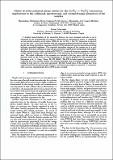Por favor, use este identificador para citar o enlazar a este item:
http://hdl.handle.net/10261/112398COMPARTIR / EXPORTAR:
 SHARE
BASE SHARE
BASE
|
|
| Visualizar otros formatos: MARC | Dublin Core | RDF | ORE | MODS | METS | DIDL | DATACITE | |

| Título: | Global ab initio potential energy surface for the O2( 3∑g -) + N2(1∑ g +) interaction. applications to the collisional, spectroscopic, and thermodynamic properties of the complex |
Autor: | Bartolomei, Massimiliano CSIC ORCID ; Carmona-Novillo, Estela CSIC; Hernández, Marta I. CSIC ORCID; Campos-Martínez, José CSIC ORCID; Moszynski, R. | Fecha de publicación: | 2014 | Editor: | American Chemical Society | Citación: | The journal of physical chemistry, A, Molecules, spectroscopy, kinetics, environment & general theory 118: 6584- 6594 (2014) | Resumen: | A detailed characterization of the interaction between the most abundant molecules in air is important for the understanding of a variety of phenomena in atmospherical science. A completely ab initio global potential energy surface (PES) for the O2(3∑g -) + N 2(1∑g +) interaction is reported for the first time. It has been obtained with the symmetry-adapted perturbation theory utilizing a density functional description of monomers [SAPT(DFT)] extended to treat the interaction involving high-spin open-shell complexes. The computed interaction energies of the complex are in a good agreement with those obtained by using the spin-restricted coupled cluster methodology with singles, doubles, and noniterative triple excitations [RCCSD(T)]. A spherical harmonics expansion of the interaction potential containing a large number of terms due to the anisotropy of the interaction has been built from the ab initio data. The expansion coefficients, which are functions of the intermolecular distance, are matched in the long-range with the analytical functions based on the recent ab initio calculations of the electric properties of the monomers [ M. Bartolomei et al. J. Comput. Chem. 2011, 32, 279 ]. The PES is tested against the second virial coefficient B(T) data and the integral cross sections measured with rotationally hot effusive beams, leading in both cases to a very good agreement. The lowest lying states of the complex have been computed and relevant spectroscopic features of the interacting complex are reported. A comparison with a previous experimentally derived PES is also provided. © 2014 American Chemical Society. | URI: | http://hdl.handle.net/10261/112398 | DOI: | 10.1021/jp503182h | Identificadores: | doi: 10.1021/jp503182h issn: 1520-5215 |
| Aparece en las colecciones: | (CFMAC-IFF) Artículos |
Ficheros en este ítem:
| Fichero | Descripción | Tamaño | Formato | |
|---|---|---|---|---|
| global.pdf | 662,83 kB | Adobe PDF |  Visualizar/Abrir |
CORE Recommender
WEB OF SCIENCETM
Citations
10
checked on 23-nov-2021
Page view(s)
320
checked on 23-abr-2024
Download(s)
217
checked on 23-abr-2024
Google ScholarTM
Check
Altmetric
Altmetric
NOTA: Los ítems de Digital.CSIC están protegidos por copyright, con todos los derechos reservados, a menos que se indique lo contrario.
